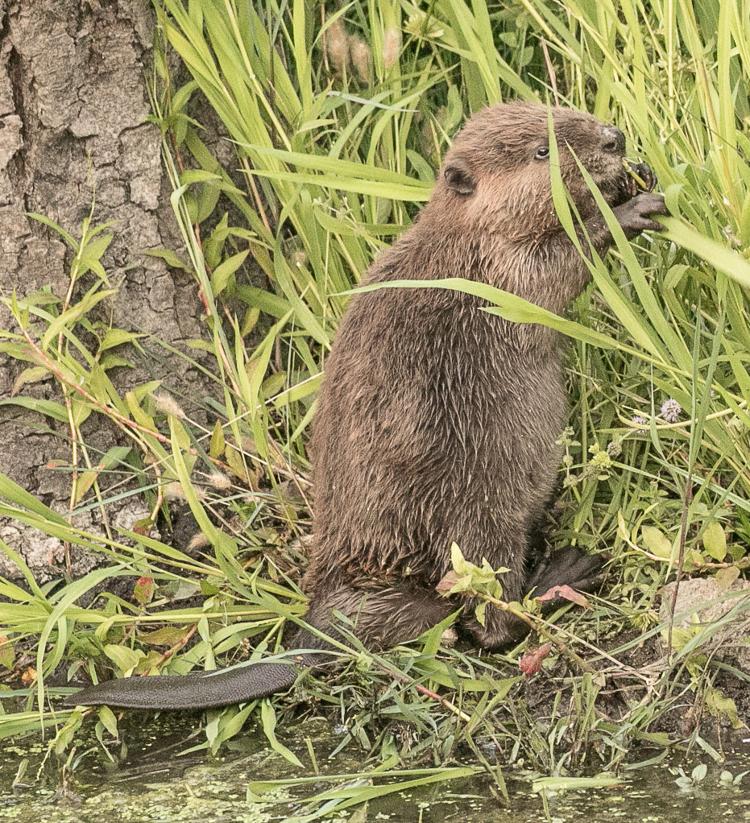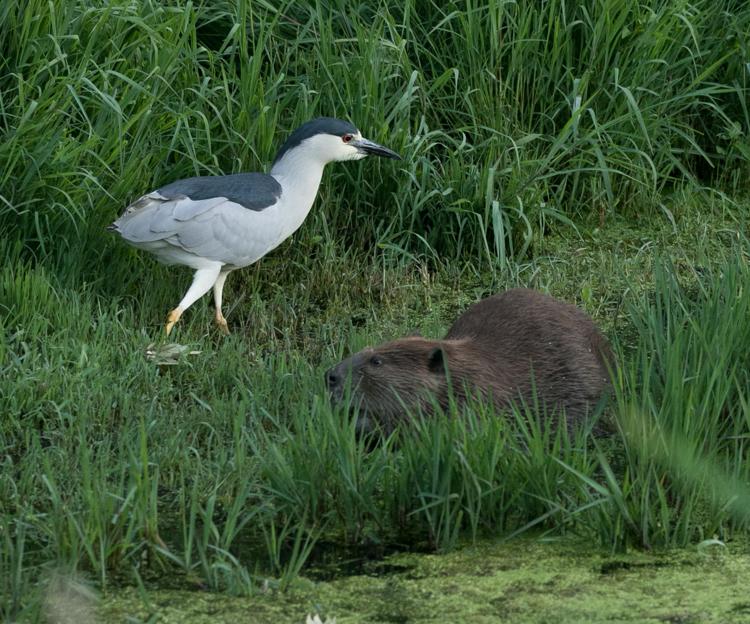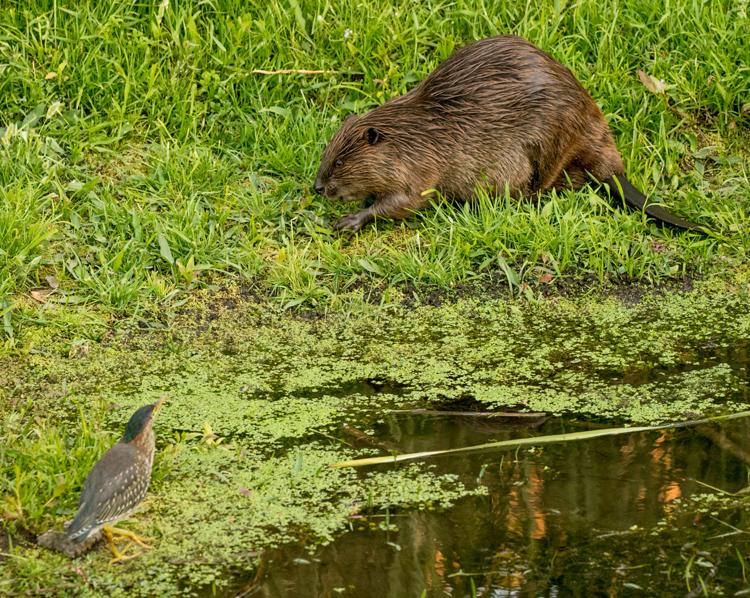Has there ever, in ALL of history, been a beaver day like August 31, 2017? There are literally 7 positive stories to cover about beavers today, each more wonderful than the last. You dream of a day like this, when you’re just starting out telling folks that beavers matter, but you never think it will happen to you! Obviously I can’t cover them all today, so I will focus on our friends, because if this website is nothing else, it’s an old boys beavers’ club. And beaver friends lives matter.
Let’s start with our good friends at the Blue Heron Nature Preserve in Atlanta Georgia. Founder Nancy Jones trekked to Martinez to visit our beavers and hear the story years ago, and even made it to the festival one year. New Executive Director Kevin Jones came out as well and brought us a beaver chew from Georgia! Nothing could make us happier than to start with this story from WABE in Atlanta. I’m told it was on the radio this morning, and a link the the audio is coming later.

Beavers In Buckhead? Yes, And They Help Restore Nature
When you think of the wildlife in a city, beavers may not be the first animal that comes to mind, but they’re all over the place in Atlanta. And while the big, goofy-toothed swimming rodents can be a nuisance, it appears beavers may also help our environment.
“What I see is just the potential for all kinds of biological processes to be happening,” says Sudduth. “Cleaning the water. The wetland hosts a huge diversity of bird life that you wouldn’t see otherwise.”
Amphibians and fish thrive in Emma Wetlands, too.
What Sudduth is especially interested in is water quality. She’s studying if this creek is cleaner because of the beavers. She’s not quite finished with that work yet, but it has been done in other places.
“There’s more and more research coming out about that,” says Greg Lewallen, a Ph.D. student at the University of Saskatchewan, who studies beavers. He co-wrote a handbook on using beavers in river restoration for the U.S. Fish and Wildlife Service, and recently wrote a new chapfocusing on urban beavers. [Eds. note: with a little help. Sheesh]
Lewallen says beaver dams trap pollutants, and wetland plants help clean the water. Out West, in states including Oregon, Idaho and Colorado, there have been some projects that actively try to attract beavers. That can save money on river restoration work that would otherwise require things like backhoes.
Beavers do it for free, with their teeth.
“They’re an incredible species,” says Lewallen. “We can relate to them in a lot of ways as humans in my opinion. They’re incredibly industrious and hard-working, and for a rodent species, they are extremely family-oriented.”
Lewallen says almost all major cities now have beaver populations. We don’t see them much because they’re nocturnal.
Hurray for Greg and BHNP. I am so happy to see urban beavers discussed on NPR, you can’t imagine. Kevin wrote me this morning and was really excited about the news. BHNP is a success story like no other, and I’m so proud of everything they achieved. I’m thrilled that this report included our chapter in the restoration handbook and talked to Greg too. If folks are going to see urban beavers differently success stories need to come from all around them. Congratulations Greg, Kevin and Nancy!
More great news about our beaver buddy in Napa, Rusty Cohn who’s fabulous photos appeared in an Essay on the beavers of Tulocay Creek. I’m not going to post every photo here, just a few favorites, but GO LOOK AT THE ARTICLE it’s well worth your time.
Photos: Life at Napa’s Beaver Lodge at Tulocay Creek
The Tulocay Creek beaver pond is located next to the Hawthorne Suites Hotel, 314 Soscol Ave., Napa. At the creek, you’ll find river otters, mink, muskrats and herons as well as beavers. Here are some photos of the critters taken by local photographer Rusty Cohn.
“Since Beavers are nocturnal, the heat doesn’t seem to bother them,” Cohn said. “They come out a little before sunset and are mainly in the water. During the day they are sleeping either in a bank den in the side of the creek bank under a fair amount of dirt, or inside a lodge which is made of mud and sticks mainly.”



Go look at the whole thing and I PROMISE you won’t regret it. Wonderful work Rusty, Napa beavers are so lucky to have you.
![]()
And wait, there’s more, this from the big glossy magazine of the center for biological diversity. Guess who finally got the memo that beaver help salmon?
To Restore Salmon, Think Like a Beaver
Manmade “dam analogues” could help beavers recolonize former habitats — and help fish in the process.
In one project landowners and public-land managers have started building structures called “beaver dam analogues,” which are essentially starter kits designed help beavers recolonize rivers.
The premise is simple: Drive a row of narrow logs into a streambed and then weave the pilings together with cuttings sourced from nearby trees. The structure slows the pace of the water and traps sedimentation, allowing a small pond to form and creating favorable conditions for nearby beavers (Castor canadenis) to move in. Then the beavers can build their own homes and continue to modify streams to meet their needs.
Their use has spread. In California Brock Dolman and Kate Lundquist, co-directors of the WATER Institute at the Occidental Arts and Ecology Center, facilitate the effort to introduce beavers to watersheds. Because the animals provide ecosystem services, Dolman and Lundquist see them as underutilized allies in watershed recovery efforts. Their handiwork transforms the landscape, creating a mosaic of habitats. First, beaver dams modify streamflow, creating slow and fast-moving bodies of water. This leads to an increase in the types of streamside habitats available to a variety of wildlife, boosting biodiversity in the process.
Lundquist says the North American beaver is the continent’s original water manager, renowned for storing and caching water for future use. Since beaver dams are temporary and permeable, she explains, the structures allow water to flow, thereby reconnecting mountain streams with the floodplains below.
As California looks for ways to become more resilient in the face of climate change and the prospect of prolonged droughts, the construction of these dams may prove to be advantageous. They could even buy more time for stressed aquatic species such as oceangoing salmon and steelhead trout, which have been left high and dry by California’s prolonged droughts, deforestation and water-diversion projects meant to help farmers.
What remains unchanged is the beaver itself. “They are highly adaptable animals and able to persist,” Lundquist says. “What limits beaver are water and wood — period.” And that combination may be a damned good way to restore streams and solve water woes in California and other parched states.
Hurray for Brock and Kate and writer Enrique Gili[s for the wonderful article. It is great to see the benefits of beavers get discussed specifically in California. We all need to start having more serious conversations about water storage and beavers in our state, so I’m grateful for this push. It is great to have this issue noticed at the upper levels.
One thing that’s not clear in the article is that actual beaver relocation in California is still illegal. Unlike many other states who understand that value of sending in beaver to work their magic, our state still thinks of them as a pest and you aren’t allowed to relocate pests. Unless you’re on tribal lands, and then you can do anything you want. I’m happy the center for biological diversity came to the party, but wish they had clarified that one nagging detail! It’s hard to organize a campaign to change the law if the folk think the law already allows it!


 MARTINEZ, Calif. – A breeze ruffled the feathers of a great horned owl that blinked at children from his tall perch. A peregrine falcon flapped his wings while Angela Mazur from Native Bird Connections held his jess leash. Both birds, who can’t return to the wild after being injured, were on display Saturday during the 10th annual Martinez Beaver Festival.
MARTINEZ, Calif. – A breeze ruffled the feathers of a great horned owl that blinked at children from his tall perch. A peregrine falcon flapped his wings while Angela Mazur from Native Bird Connections held his jess leash. Both birds, who can’t return to the wild after being injured, were on display Saturday during the 10th annual Martinez Beaver Festival. Most notably, the award-winning biologist Brock Dolman, dressed and portraying his character Buster Beaver, drawled a folksy explanation of the importance of beavers in the ecosystem and how they are affected by the sequences of drought and winter rains.
Most notably, the award-winning biologist Brock Dolman, dressed and portraying his character Buster Beaver, drawled a folksy explanation of the importance of beavers in the ecosystem and how they are affected by the sequences of drought and winter rains. Other organizations promoted recycling, such as The Garden at Heather Farms booth, where visitors could learn to weave using natural materials, and the Republic Services booth, where R.C. Ferris took old badges, covered them in double-faced tape and showed visitors how to decorate the sticky badge faces with stickers, moss, leaves and other materials to turn them into works of art.
Other organizations promoted recycling, such as The Garden at Heather Farms booth, where visitors could learn to weave using natural materials, and the Republic Services booth, where R.C. Ferris took old badges, covered them in double-faced tape and showed visitors how to decorate the sticky badge faces with stickers, moss, leaves and other materials to turn them into works of art. Plenty of children lined up for the program books that guided them through nine booths where they learned about water, frogs, otters, herons, fish and dragonflies in addition to the beavers and pond turtles. Those who completed their visits collected tattoos they could use in making nature journals.
Plenty of children lined up for the program books that guided them through nine booths where they learned about water, frogs, otters, herons, fish and dragonflies in addition to the beavers and pond turtles. Those who completed their visits collected tattoos they could use in making nature journals.

 Donald discovered that his land had experienced some heavy flooding. The culprit appeared to be an industrious beaver clan that had built a 6-foot-tall dam across Fairview Creek under the railroad bridge. While the Multnomah County Drainage District No. 1 could technically lower the waterline at Fairview Lake, this wouldn’t remove the dam or solve the long-term problem with flooding.
Donald discovered that his land had experienced some heavy flooding. The culprit appeared to be an industrious beaver clan that had built a 6-foot-tall dam across Fairview Creek under the railroad bridge. While the Multnomah County Drainage District No. 1 could technically lower the waterline at Fairview Lake, this wouldn’t remove the dam or solve the long-term problem with flooding.![annex-keaton-buster-general-the_06[1]](https://www.martinezbeavers.org/wordpress/wp-content/uploads/2017/06/annex-keaton-buster-general-the_061-300x241.jpg)



 Beaver are nature’s ecosystem engineers, felling trees and building dams, and changing waterways for their own benefit. But they also benefit other species in the process, including humans as well as many species that are now in jeopardy at least in part due to the historic loss of beavers. Their dams help to control the quantity and quality of water downstream, which both humans and animals use. Their ponds and flooded areas create habitat for many plants and animals, such as fish, birds, insects, and amphibians. In fact, some species only live near beaver ponds. Beavers dramatically change their environment, and those changes can last for hundreds of years, even after the beaver have moved on.
Beaver are nature’s ecosystem engineers, felling trees and building dams, and changing waterways for their own benefit. But they also benefit other species in the process, including humans as well as many species that are now in jeopardy at least in part due to the historic loss of beavers. Their dams help to control the quantity and quality of water downstream, which both humans and animals use. Their ponds and flooded areas create habitat for many plants and animals, such as fish, birds, insects, and amphibians. In fact, some species only live near beaver ponds. Beavers dramatically change their environment, and those changes can last for hundreds of years, even after the beaver have moved on.





































